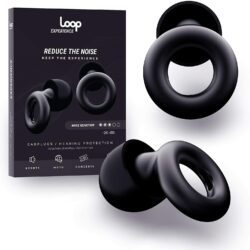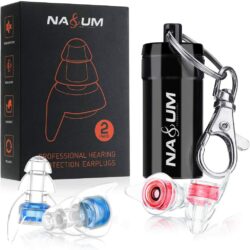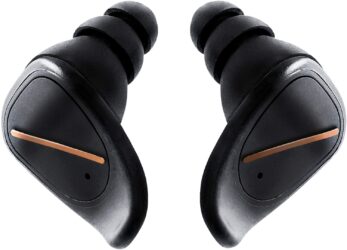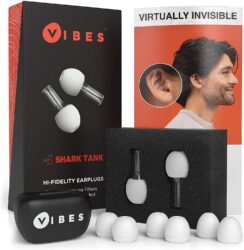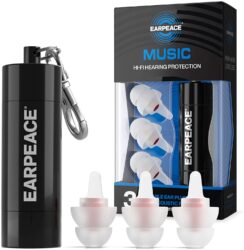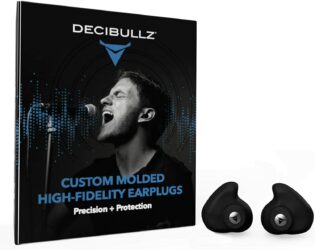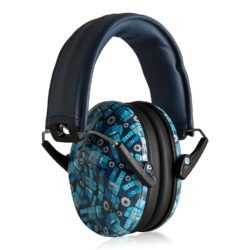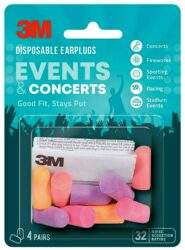Concerts are an incredibly popular form of recreation for many, but they could be hiding something a bit more sinister: the potential for hearing loss and damage. While there are few better feelings than being amongst a massive crowd at a concert, there are some drawbacks: principally, the loud speakers and concert noises that can leave you with ringing ears.
If that has ever happened to you, you’re at risk for hearing loss and tinnitus that can be permanent. The only solution is protecting your hearing with a set of earplugs, principally music-specific earplugs that help maintain high-fidelity music while lowering the damaging tones that can hurt your ears.
- Features to Consider in Concert Earplugs
- Top 10 Best Concert Earplugs 2025
- 1. Best Overall Concert Earplugs: Loop Earplugs for Noise Reduction
- 2. Best Budget Concert Earplugs: Nasum High Fidelity Concert Earplugs
- 3. Best All-Day Concert Earplugs: Eargasm High Fidelity Earplugs
- 4. Best Premium Concert Earplugs: Earos One High Fidelity Acoustic Filters
- 5. Best Disposable Concert Earplugs: Flents Ear Plugs
- 6. Most Comfortable Concert Earplugs: Vibes High Fidelity Earplugs
- 7. Best for Festivals: EarPeace Concert Ear Plugs
- 8. Best Concert Earplugs for Musicians: Decibullz Custom Molded Professional Filters
- 9. Best for Kids: Muted Designer Hearing Protection for Kids
- 10. Most Varied Color Options: 3M Disposable Earplugs for Events and Concerts
- FAQ
- Guide to Buying the Best Concert Earplugs for 2025
- Wrapping Up
Features to Consider in Concert Earplugs
For a simple device that’s really just meant to cover your ear up, there’s a lot that goes into a concert-quality earplug. A concert earplug isn’t just about minimizing the noise, you’ve also got to maintain audio fidelity and make sure to avoid blocking out the most important tones.
Purchase the right earplugs for you by paying close attention to the features listed below:
Material
From simple and inexpensive foams to high-quality, scientifically-advanced composites, the most important factor in creating a comfortable and noise-isolating earplug is the material.
We’ll list some of the most common versions below and discuss some of the advantages and disadvantages of each material.
Silicone
Silicone has the advantage of being non-irritating and hypoallergenic, a good option for those who are irritated by harder plastics or other materials that incorporate latex. It’s pricier than alternatives, however.
Foam
Foam earplugs are typically used with disposable designs as the moldable yet inexpensive material adapts to the ear as it heats up and expands after being compressed before insertion.
Plastic
Plastic earplugs are popular for manufacturers who make molded, custom fit options, as plastic polymers can be heated up, shaped to the ear, and then maintain a great fit after the fact. They can be quite hard, which is uncomfortable, but offer the best and most accurate shape.
Reusability
Some expensive earplugs are meant to mold to your ear, creating a perfect fit that can be used over and over again, while others are single-use: just pop them in and take them out at the end of the night. At the end of the day, it’s up to personal preferences as to which type you prefer, but for the best fit and a minimal amount of waste, we’d recommend a reusable plug.
For hygiene, and convenience, consider a disposable option. If you’re price sensitive, a reusable earplug purchase starts out more expensive but evens out as you begin to work through your supply of disposables.
Unobtrusiveness
While a set of noise-isolating ear muffs might be great for landscaping work, the truth is that no one wants to go to a concert with muffs, or even with a set of earplugs that is connected via some type of plastic cord. The smaller and less visible a pair of earplugs is, the better. Nearly all concert-goers prefer earplugs.
Kids, however, often find a pair of earmuffs more comfortable when attending a concert. While we are accustomed to actually inserting things like earplugs in our ears, most kids find in-ear plugs uncomfortable and inconvenient. Earmuffs are more useful and, while they don’t preserve sound quality, the most popular option for parents.
Comfort
Earplugs are no good if you’re not going to wear them: you’ve got to prioritize comfort. There are two components to this: the material and the shape itself both affect the user experience of the earbud. Make sure the material is soft and can adapt the shape of your ear; also make sure that the fixed construction suits your comfort and your anatomy.
Noise Reduction Rating (NRR)
Earplugs sold in the US are required by law to have an NRR, a governmentally certified rating of protection. This decibel isn’t a positive decibel rating (how you would measure a noise source), but actually a negative one that measures by how much the earplugs can reduce noise. For example, an NRR of 25 will reduce a 100-decibel rock concert to a safe 75 decibels.
Bonus Features
Other things that users might look for are extra tips, additional styles of tips, and a carrying case or bag. These are convenient, but definitely not make-or-break.
Without further ado, let’s get to work on protecting your hearing!
Top 10 Best Concert Earplugs 2025
1. Best Overall Concert Earplugs: Loop Earplugs for Noise Reduction
Why we like it:
These phenomenal earplugs are surprisingly inexpensive considering how well they fit, how attractive their design is, and the fact that they maintain sound quality incredibly well.
Quick Specs:
- Material:Foam / Plastic
- NRR:20 decibels
While these earplugs reduce sound by about 20 decibels per ear, the true innovation is their ring-shaped sound filters. These rings shape sound, reducing noise levels by about 20 decibels but letting the finer tones pass through at a lower volume.
These filters also serve as handles to remove and insert the earplugs. While the execution of the design is impressive, and they’re one of the best-looking plug sets on the market, they filter out bass a little more than higher tones, leaving the resulting filtered sound a bit tinny.
They come in three sizes, with each purchase including two sets of small, medium, and large earplugs (one each of both silicone and foam). That makes your first purchase great, as you’re sure to find a model that fits, but your following purchases a bit trickier, as you’ll end up with four pairs of earplugs you don’t need every time you buy.
That doesn’t just feel wasteful to us, but it also feels like it drives up the price: something that we’re not a fan of considering that these earplugs are already well above average in terms of price.
Pros
- Ring filters help round out sound and reduce volume
- Drop noise levels by about 20 decibels
- One of the best-looking sets on the market
- Multiple sizes mean it's easy to find a good fit
Cons
- Multiple purchases yield wasted earplugs and wasted dollars
- Tone filters don’t let much bass through, making them a bit tinny
2. Best Budget Concert Earplugs: Nasum High Fidelity Concert Earplugs
Why we like it:
These inexpensive earplugs incorporate an internal plastic filter at a low price, so they’re simultaneously effective for high sound quality as well as incredibly accessible from a price perspective.
Quick Specs:
- Material:Silicone / Plastic
- NRR:25 decibels
Similar to the recommended-for-musicians EarPeace Concert Ear Plugs, these sound barriers are comfortable and snug-fitting with a silicone construction, although they still manage to produce great sound quality by using an internal plastic filter that evens out sound quality across the spectrum. The set comes with two pairs and a carrying case.
But what’s best about these earplugs is their price: these earplugs come in at under five bucks per pair, pretty impressive considering the fact that some higher-end disposable models can cross the dollar-per-pair line.
So really, they are nearly disposable, especially when compared to fully custom models or even lined up next to premium models like Decibullz Custom Molded Professional Filters that are meant for true audiophiles. Sure, sound quality isn’t as great, but for the price, it doesn’t need to be.
Pros
- Price means they’re practically disposable, especially next to high-end plugs
- Great sound quality thanks to an internal filter technology
- Set comes with two pairs and a carrying case
- Snug-fitting silicone construction
Cons
- Sound quality isn’t as impressive as high-end models
3. Best All-Day Concert Earplugs: Eargasm High Fidelity Earplugs
Why we like it:
These plugs have a flexible construction and phenomenal audio quality, resulting in a pair of high-fidelity earplugs that are comfortable enough to be left in all day.
Quick Specs:
- Material:Hypoallergenic Silicone
- NRR:21 decibels
As far as maintaining high audio quality goes, nothing aside from ultra-expensive totally custom earplugs can really beat these high-fidelity earplugs from Eargasm, although finding a perfect fit can be a bit tricky.
They include two sizes with every set, but they’re two different sizes, which means once the properly-fitting pair wears out, you’re out of luck. Thanks to their flexible construction, at least one of the two pairs should fit you properly, and once they’re in and fitting properly, they’re comfortable.
The trick behind isolating a full 21 decibels of sound while still managing to maintain phenomenal, high-fidelity sound is the use of innovative attenuation filters (they’re patent pending). These ridged, internal contraptions don’t isolate a specific frequency as inexpensive earplugs do, which enables you to enjoy the full range of sounds at a concert: they take the edge off the dangerous volume without removing the deepest bass sounds and highest trebles of soft voices and gentle guitars.
Unfortunately, they’ve got some problems with comfort, and they get dirty and hard-to-clean pretty quickly. They’re also one of the more expensive options in our lineup but come in at a fraction of the price of fully custom.
Pros
- Enable you to enjoy a full range of sounds at a concert
- Quiet down sounds while letting you enjoy both treble and bass
- Available in two different sizes
Cons
- Can get dirty relatively quickly
- One of the more expensive high-fidelity earplugs in our lineup
Why we like it:
These comfortable, anatomically shaped earplugs were designed in collaboration with the former director of MIT’s Acoustics and Vibratory lab, yielding a phenomenal fit and excellent noise reduction.
Quick Specs:
- Material:Foam
- NRR:17 decibels
While these pricey earplugs are a bit tricky for some to justify, given the price, others are more than happy to pay a premium price for a product that maintains high audio fidelity while isolating a near-20 decibels worth of sound. This takes loud music at concert venues well below the harmful range.
These earplugs filter rather than dull loud sounds with a design developed in conjunction with the former director of MIT’s Acoustics and Vibratory lab. They’re quite comfortable, as they’re designed with the natural curve of your ear in mind.
They’re designed and made in the US, which is a quite significant advantage: not only can you feel good about supporting American-made products, but you’ll also feel good about the durability of the product you’re purchasing.
The manufacturer backs these plugs up with a limited product warranty, although they’ll still naturally wear out over time and require replacement. They have a relatively long useful life, but with a price tag this high, we expect nothing less.
Pros
- These earplugs filter sounds rather than dulling them, improving fidelity
- Designed and produced in the United States
- Limited product warranty coupled with long useful life
- Developed in conjunction with the director of MIT’s Acoustics and Vibratory Lab
Cons
- Lifetime warranty doesn’t prevent natural wear and tear
5. Best Disposable Concert Earplugs: Flents Ear Plugs
Why we like it:
If you’re put off by the idea of long-term reusable earplugs, these inexpensive yet effective disposable earplugs could be a good option.
Quick Specs:
- Material:Foam
- NRR:29 decibels
These disposable foam options are meant for users who require the convenience or the hygiene of single-use plugs, these could be a good option. With a 29 decibel NRR (noise reduction rating), they’re actually a bit too potent for a lot of users: we find the ideal range is around a 20-decibel reduction for a good compromise between hearing safety and audio enjoyment. Compress them down between your index finger and thumb before insertion, then pop them in.
They’re designed without the inclusion of any latex, fantastic for anyone with a sensitivity or allergy. They’re also produced in the United States, which speaks to their high quality: no annoying in-ear crumbling or use of materials that degrade over time.
Unfortunately, as disposable plugs, they’re not great for the environment, and you’ll have to toss them after every use. For this reason, most concert-goers prefer non-disposable, acoustic-friendly versions.
Pros
- No in-ear breakage of earplugs or material degradation
- Produced in the United States
- No latex means minimal allergic reaction risk
Cons
- 29 decibels of noise reduction is a bit excessive for most concerts
- Disposable options aren’t great for the environment
6. Most Comfortable Concert Earplugs: Vibes High Fidelity Earplugs
Why we like it:
These earplugs took high-fidelity hearing protection into the mainstream with a scientifically-backed design and a placement on nationally-broadcasted TV show, Shark Tank.
Quick Specs:
- Material:Foam/Plastic
- NRR:15 decibels
After the owner of this company blew out an eardrum at a gig in his native city of Minneapolis, he started looking for earplug options that wouldn’t destroy the richness of the sound quality of music. He came up with these products, which have since then been seen on the famous network TV show Shark Tank, where they advertised the points that attracted us to this product: comfort, high-fidelity sound, and a balanced reduction in volume.
But, as we know from this extensive list, earplugs that protect sound quality aren’t uncommon in this day and age, whether they’re directed at concert-goers, musicians, or both. So what makes these different from similar devices? The answer is principally in the form factor. They’ve actually got a plastic handle to help with insertion and removal, a handle that’s really the main part of the earbud.
The rest of the device, the actual hearing insulation itself is replaceable, with each set coming with three separate size options. That’s great for finding a good fit, but since only one earplug will be a good fit, the rest go to waste.
Pros
- Each set comes with three different sizes
- Plastic handle helps with insertion and removal
- Each set comes with three separate sizes
- Ridiculously comfortable fit
Cons
- Include extra earplugs that will be wasted if they don’t fit
7. Best for Festivals: EarPeace Concert Ear Plugs
Why we like it:
This set of hypoallergenic silicone plugs come with three different decibel filters, each of which can optimize sound for a different type of concert.
Quick Specs:
- Material:Silicone
- NRR:17 - 26 decibels
Finding a pair of earplugs for a musical festival presents some unique challenges: you want a pair that’s inexpensive enough to not worry about too much but that’s still reliable and comfortable.
You also want a single pair so as to not worry too much about the hassle of lugging around a few days’ worth of extra plugs in your bag. These under-$30 earplugs do the trick by combining a plastic filter with hypoallergenic silicone for a comfortable but effective earplug.
The plugs have three separate decibel filters, with the most subtle one rated to 17 decibels and the heaviest-duty filter rated to a powerful 26 decibels. That’s probably a bit much for a quieter concert, but could be a good option for a rock, hip-hop, or metal concert.
The silicone plugs themselves are available in two sizes, standard and small. We wouldn’t mind a larger version, but the standard fit should fit most users. A carrying case that attaches to your keychain is great so that you’ll always have them on hand, just remember to periodically clean them with a mild cleanser.
Pros
- Great for use at music festivals
- Include a carrying case that attaches to your keychain
- Reliable and comfortable for long periods of time
Cons
- Need to be cleaned periodically with a mild cleanser
- Only comes in ‘standard’ and ‘small’ sizes
8. Best Concert Earplugs for Musicians: Decibullz Custom Molded Professional Filters
Why we like it:
For concert musicians on a budget that need a custom fit and use earplugs every night, there aren’t any options better than these heat-moldable plugs
Quick Specs:
- Material:Heat-moldable Plastic
- NRR:17 decibels
The inventor of these highly-customizable concert earplugs designed this product to create a set of earplugs with a custom fit that filter out dangerous noise while maintaining high-quality audio. They start out as a softish plastic, then they’re heated up and placed in the ear to mold, where they harden for a perfect fit.
While the molding process is relatively simple, even if you can’t get them to set up correctly, you can reheat them to reset them. This will cause a small drop in plasticity and can affect the long-term durability if done too many times, but a single reset can drastically improve fit.
While they’re not the most comfortable earplugs in the world, they’re pretty much the best option for high fidelity audio. They filter out about 17 decibels, enough to take a 100-decibel concert (in the danger zone) down to about 80 decibels, which is the equivalent of a busy restaurant—well outside of the danger zone.
It does all this while maintaining fantastic audio pass-through, so you don’t miss the bright high tones nor the deep, lower tones.
Pros
- Custom earplugs perfectly mold to your ears when heated up
- Can be reset if the fitting process isn’t performed properly
- Quiets sounds without dulling bright or deep tones
- Filter dangerous noise levels down by about 17 decibels
Cons
- Not the most comfortable earplugs in the world
- Resetting them by heating them too much can reduce structural integrity
9. Best for Kids: Muted Designer Hearing Protection for Kids
Why we like it:
These earmuff style hearing protectors protect children’s’ ears in a comfortable, attractive, and effective form factor.
Quick Specs:
- Material:Plastic frame, foam insulation
- NRR:27 decibels
These headphones are rated to a powerful 27 decibels of noise reduction, enough to take even the loudest of concerts down to a safe level. They’re an earmuff format, with several patterns available—a couple more girly, a couple more for boys, and a couple of gender-neutral designs. For protecting a child’s hearing or helping out sensory-challenged kids, there’s nothing better.
There are just a couple of issues: firstly, these are neither designed for adults nor are they large enough to even fit an adult’s head. And if your child is headed to a concert and hoping to enjoy the detailed music of a concert, this isn’t a great option either: the construction and design of earmuffs meant that the audio fidelity simply isn’t preserved. It’s like trying to listen to a sound system in another room.
But if a child is tagging along to a loud event and is looking for relief from louder noises, or is more susceptible to sensory overload, these are a great choice.
Pros
- Meant to fit children's heads and needs
- Powerful 27 decibels of noise reduction
- Can be incredibly effective children who experience sensory overload
- Different, cute designs for all kinds of tastes
Cons
- Can’t fit an adult head
- Don’t preserve audio quality
10. Most Varied Color Options: 3M Disposable Earplugs for Events and Concerts
Why we like it:
3M is a well-respected personal protective equipment manufacturer, and with these earplugs, they back up the quality of their products with a comfortable and effective pair of protection.
Quick Specs:
- Material:Foam
- NRR:32 decibels
3M has a fantastic reputation of producing great PPE (personal protective equipment), and these multicolored foam plugs are no exception. Between an inexpensive, disposable design that helps with convenience and hygiene and a low price tag, these 3M plugs both fit comfortably and stay put. Each pack contains four pairs, each with a different color.
There are a couple things to be aware of before purchasing these earplugs. A noise reduction rating of 32 decibels is great for protecting your hearing, but as far as preserving audio quality goes, it leaves quite a bit to be desired. If you’re simply looking to protect your hearing at a really loud concert or event (maybe a rave, heavy metal concert, or a nightclub), the high NRR can be incredibly helpful for audio health.
If you’re headed to a folk concert, perhaps, and want to hear the intricacies and fine tones of a more delicate genre, we’d recommend a pair of more audiophile-minded earplugs like the Decibullz Custom Molded Professional Filters.
Pros
- Comfortable, great fitting foam earplugs
- Inexpensive and disposable design
- Company has a great reputation of producing phenomenal PPE
- Each pack includes four differently-colored pairs
Cons
- Sound quality leaves a lot to be desired
- 32 decibel noise reduction rating is a bit much
FAQ
Plenty of people, from construction workers to factory employees wear earplugs all day, every day. You shouldn’t have any difficulty doing it either. Counterintuitively, however, if you plan on wearing earplugs every day for a long period of time, think about switching to disposable earplugs. While custom earplugs provide a good fit, the way they’re meant to be reused means repeated use can increase the probability of an infection.
Expert guidance and studies show that nearly all concerts exceed recommended noise limits from audiologists. While famously loud events (heavy metal, EDM sets, rap, and rock concerts) obviously require hearing protection, it might be prudent to use hearing protection even at tamer events. If a powered amplification system is being used, there’s a potential for hearing damage. So while you’re safe at an orchestra concert, most popular music genres probably warrant hearing protection.
You should also wear earplugs to other high-noise environments. Raves, nightclubs, DJ sets, for instance, commonly exceed recommended noise guidelines and thus can be damaging to your hearing. The only way to prevent damage is to not attend or pop in a pair of earplugs.
For musicians, hearing the intricacies of soft and loud tones alike is their livelihood. Someone who truly relies on their ears can show you how much preserving your hearing really matters. Next time you’re at a concert, see if you can spot a musician using earplugs. Among professionals, they’re getting more and more popular, and for good reason. Especially with options like the Decibullz Custom Molded Professional Filters that preserve audio fidelity, there is no excuse to not pick up a pair.
While they certainly come at a price premium, the latest tech in earbuds is incredibly effective but highly-priced. We consider a pair of electric earplugs to be one of the best ways to isolate noise in general, cutting decibels hugely, although they’re not really effective in a concert situation, as to work you need to be actively playing music for them to isolate sound.
Guide to Buying the Best Concert Earplugs for 2025
If your hearing is damaged, it simply doesn’t come back. That’s why it’s so important to protect it. If you’re a fan of live music, the loud sound systems and crowds don’t necessarily get along with your ear health.
To enjoy live music and keep your hearing intact, pick up a pair of earplugs to protect yourself.
How Does Hearing Loss Work?
To understand when, how, and why to use your earplugs, you need to know a bit about hearing loss itself. This ailment affects millions of people, with some experiencing it from birth based on genetic origins and others experiencing it over time as they don’t take care of their hearing. Your auditory system consists of several parts, the most important ones being your eardrum, the nerve cells in your cochlea, and your stereocilia (inner ear hairs)
Repeated exposure to loud noises, at a concert, for example, can essentially cause wear and tear on these delicate parts of your ear. By covering your ear, you reduce the intensity of the vibrations that reach your ear and thus eliminate to a large extent the risk of hearing loss.
Custom Earplugs
While models like Decibullz Custom Molded Professional Filters are customizable to some degree, many audiologists are tremendous advocates for a true pair of custom earplugs, and plenty of professional musicians and even some avid concert goers will tell you that the $200 to $300 price tag is well worth it.
How Are Custom Earplugs Made?
You’ll need to go into an office to get the impression done; the process is typically done with a resin-like composite that’s slowly placed in your ear as you open and close your jaw to create a good fit.
They then pull out the impression and send it to a lab where the actual earplugs will be made. Typically you can choose between different noise levels, from 9 decibels of isolation to up to 25.
What Are the Benefits of Custom Earplugs?
The main benefit of this is the incredible sound quality this technique preserves. It doesn’t isolate one tone or another, meaning that, across the audio spectrum, the music you listen to will be quieter, but of equally high fidelity.
Another benefit is that once your earplugs need replacement, you’ll be able to order a new perfectly-fitting pair without too much trouble, as most facilities that do impressions keep them on hand forever. That will save you both the trip to the office and the price of taking the impressions.
If you’re not limited by budget, they’re the gold standard, but in-house moldable options can save some money and produce near-professional results.
Inserting Disposable Earplugs
Many first-time earplug users complain about earplugs that fall out or don’t fit properly, but foam disposable earplug manufacturers have had it figured out for a while by now. Disposable earplugs are designed to shrink down for easy insertion, then expand to fit properly and create a comfortable and impermeable seal in your ear canal.
Follow the steps below for comfortable, safe use.
Step 1: Compact the Earplug
Take your earplug and roll it between your fingertips horizontally as if you were trying to make the cylinder narrower and longer.
Don’t be afraid to compact it quite tightly—it will spring back into place.
Step 2: Insert Earplug
Pull up your ear by the tip vertically with a decent amount of force. This will open up your ear canal and create a direct, straight line by which you can insert the earplug.
Insert it in fully so that it is flush with the rest of the ear canal. It should be completely inserted, but not so far that it can’t be removed.
Step 3: Leave the Earplug Alone
Once the earplug is inserted, stop messing with it. Earplugs are designed to let the ‘good’ noise in but chop off the top, the loudest frequencies. You shouldn’t have to remove an earplug to hear your friends talking at a normal volume, but removing it will contaminate the earplug and reduce its elasticity.
They’re really designed for a single use: that means one cycle of a single insertion and a single removal.
Step 4: Remove Earplug
Grab the earplug by the tip and slowly pull it out with a wiggling or screwing motion. This should gradually release the pressure, preventing pressure and damage to your eardrum. Discard the earplugs properly and don’t reinsert them in your ears.
For even more guidance and some visual diagrams, check out the CDC guide for earplugs here.
What Kind of Protection Do I Need?
The protection level, measured by NRR, varies depending on the environment and volume of the setting you’re in. The rough idea is to keep your perceived noise level below about 80 decibels and you should be in the clear. Subtract your NRR from the concert’s noise level for a total noise rating.
We list some common concert noise levels below; keep in mind, the numbers are approximate:
- 90 decibels: Outdoor Concerts, Festivals
- 100 decibels: Orchestra Concerts
- 110 decibels: Rock Concert, DJ Set,
- 120 decibels: Brass Band Concert (in the Orchestra)
Earbud Tips and Tricks
There are millions of people that use their earplugs for work, recreation, and protection, and they’ve picked up more than a few tips along the way. The following tips, tricks, and hacks can help you out enormously if you’re a frequent or even a casual user.
Earplugs for Tinnitus
Tinnitus, an omnipresent high-pitched noise, affects about 15 to 20 percent of Americans. Insertion of disposable earplugs can prevent development of the disease and reduces perception of tinnitus in the day-to-day.
Fit Tips
Earplugs are made in different sizes for different sized ears. You probably have a rough idea of your ear canal size based on earbuds or other earplugs you’ve used in the past, but understand that size is important, and you may have to try a few options before you can get the right fit.
Hold the Earplug in Place
Flexible earplugs take a bit of time to set properly: you can’t just shove them in, as they’ll reform and push themselves out. If you’re having trouble with your earplug staying in, insert your earplug normally but hold them in as they adapt.
After about 30 seconds, the form should adapt to your ear, making it more likely to stay in place.
Pull on Your Eartip
Your ear canal isn’t straight, but earplugs aren’t designed to be completely anatomically accurate. Pull up on the top of your ear to help align your ear canal. Once you’ve inserted the earplug, let go of your ear to realign the canal and hold the earplug in place.
Earplugs, Health, and Safety
While earplugs are downright vital for ear safety if you’re headed to a noisy concert, there are a couple of considerations you’ll want to keep your eye out for to take care of your ears. A foreign object in your ear canal does present some risks, so you’ll want to keep your eye out for that.
While earplugs undoubtedly protect your ears, there are both short-term and long-term risks to ear health.
Short Term Risks
- Some users are susceptible to allergic reactions when using earplugs, specifically with compounds like rubbers and latex. If you’ve got a history of allergies, make sure you check out the list of compounds used before inserting the earplugs.
- When inserting an earplug, make sure you’re not pushing it in too quickly or too violently. This can raise the air pressure and damage your eardrum. When inserting or removing an earplug, slowly use a screwing motion or jiggle it out to avoid these big pressure changes.
- Avoid pushing an earplug in too far or it can push earwax into your ear canal against your eardrum. This can cause a range of side effects from tinnitus to permanent hearing damage.
Long Term Risks
- Long term use can create gradual buildup of earwax in your ear canal that can plug the outer ear. This can cause hearing loss, infection or tinnitus. If you’re frequently going to concerts, wash your ears with a mild cleanser to remove earwax and clean your earplugs if you’re using a reusable version.
- Repeated use and jostling could cause irritation to the skin. If you’re using earplugs often enough to cause this inner-ear irritation or chafing, consider a custom-molded pair of earplugs.
- One of the most fragile organs in your body is the eardrum, and it should be protected from scratches, over-insertion, repeated pressure changes, or earwax buildup. If it hurts, back off or grab a different pair of earplugs.
Keep in mind, though, that earplugs are generally incredibly safe and provide huge net positives to your health and quality of life by protecting your hearing. Don’t skimp on hearing protection or you’ll regret it later.
Wrapping Up
While earplugs aren’t the most popular at concerts and DJ sets, they are incredibly prudent to use. 50 years ago motorcyclists, didn’t use helmets, children didn’t use car seats, and drivers didn’t use seatbelts. We’ve saved thousands of lives since then by changing these precedents.
That same change is now happening with hearing protection. People are beginning to understand how valuable their hearing is and how if it goes away, it never comes back.

